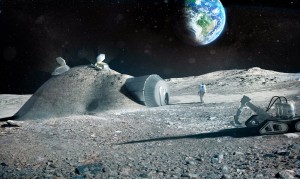 |
| Lunar Base Proposed For 3D Printing Creation |
In October 2014, over 350 experts gathered at the European Space Agency’s ESTEC Technical Centre in the Netherlands. There, they shared ideas regarding 3D printer uses relevant to the space industry. The two-day workshop was entitled “Additive Manufacturing for Space Applications.” During the gathering, experts worked on developing common standards for the use of 3D printing by the space industry.
3D Printing a Lunar Base
This gathering followed last year’s feasibility study by the ESA regarding possibly using 3D printing to create a lunar base. The wide range and scope of 3D printing is well-illustrated by this proposal.
A Prototype Building Block Created
In 2013, the ESA and its industrial partners explored whether it might be possible to actually use lunar material to fabricate 3D structures. The ESA concluded that, in theory, it is indeed possible. In fact, a 1.5-ton building block was created using 3D printing and material similar to that found on the moon’s surface. A hollow closed-cell design is claimed to offer protection against both space radiation and micro-meteoroids.
Potential Lunar Base Location Identified
Using the building block concept as inspiration, architectural firm Foster+Partners developed the necessary architectural ideas for 3D printing a lunar base at the rim of Shackleton Crater at the moon’s south pole. That site was selected for two reasons. First, it provides an almost constant source of solar light that could be employed to power the facility. Second, because sunlight merely grazes the surface at the lunar poles, these regions do not experience the temperature extremes found across most of the lunar surface. As a result, the heating and cooling requirements for the proposed lunar base will be reduced in the vicinity of the Shackleton Crater.
Next, Melting Binding Material on the Moon
Next, the agency intends to explore the feasibility of using concentrated sunlight to melt lunar material into a binding liquid. This would be an important achievement, because the transportation of such binding fluid to the moon would be inherently expensive. If binding fluid can be fabricated on the moon, the concept of a 3D printed lunar colony will move even closer to becoming a reality one
day.
Checkout the latest on 3D Printing or Additive Manufacturing
